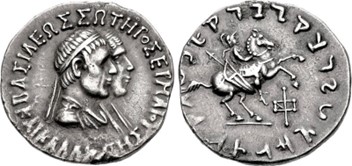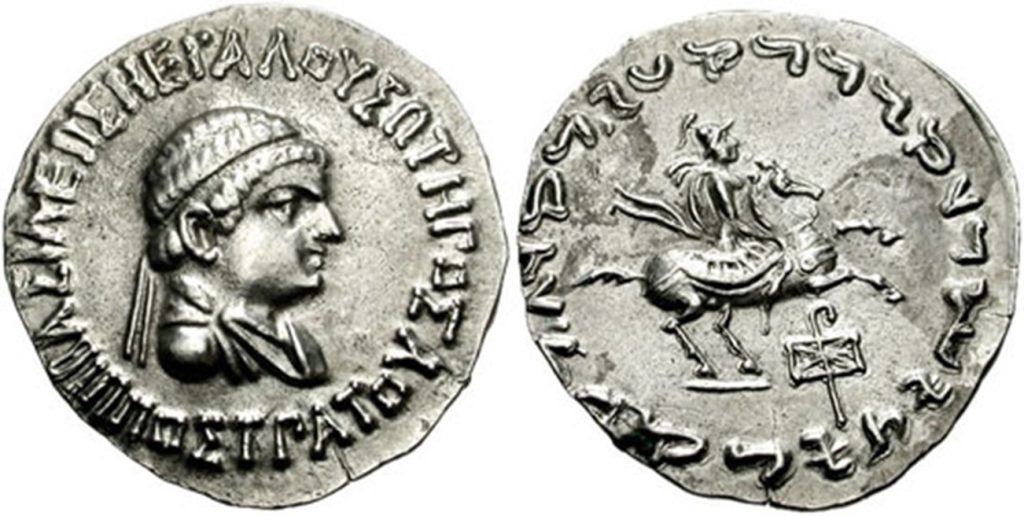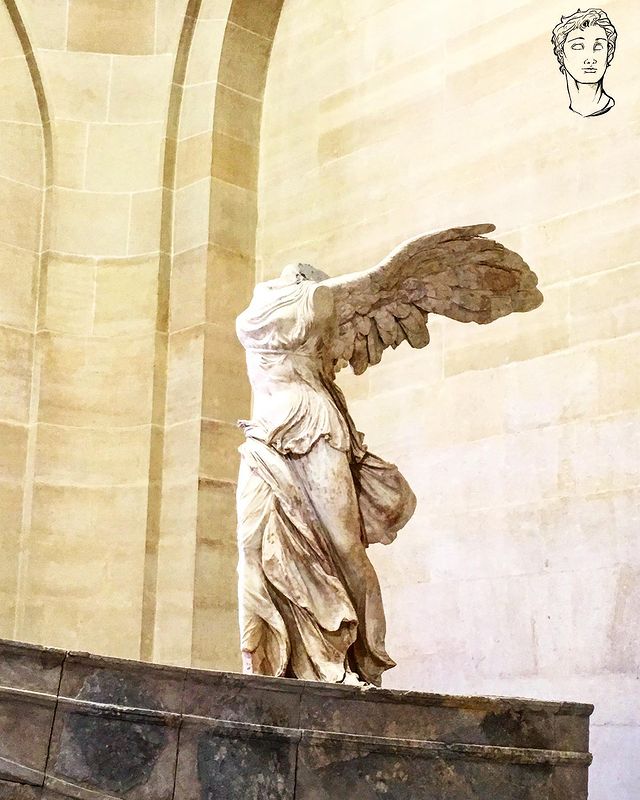Very few people know that approximately 40 years after the death of the famous Cleopatra, a date generally considered to be the end of the Hellenistic period, a Greek king named Strato III still reigned over a small territory in eastern Punjab. He was the last of dozens of rajahs in ancient India descended from the soldiers of Alexander the Great. In Today’s guest Post Jaume Galiana, who runs the Helenismania profile on Instagram, tells us more about the Yavanarajas.
These Yavanarajas, which we could translate as Greek kings, ruled much of present-day Afghanistan, Pakistan, and India for almost 200 years. One of them, Amyntas, minted the largest silver coins of Antiquity. And yet, we have no more information about most of these kings than what numismatics can give us and the hypotheses that we can extract from them. This is the real reason why the Indo-Greeks are generally unknown to the general public and sometimes only briefly mentioned in general works about the Hellenistic age.
The rulers of the “yavanarajya”, the Greek kingdom, were descendants of Greek settlers and soldiers who had lived in Central Asia since Alexander’s conquest. They later reconquered the Indian territories which had once subdued the Macedonian conqueror following the campaigns of the Greek kings of Bactria (present-day Afghanistan).

Coin of the Graeco-Bactrian conqueror Antimachos I with an elephant and a Nike. Classical Numismatic Group, Inc. http://www.cngcoins.com
When the new territories of India conquered by the Greco-Bactrians separated from their kingdom, what we know as the Indo-Greek kingdoms then appeared. However, all of these territories were united only for a very short time. While some kings ruled from Alexandria in the Caucasus and Alexandria in Arachosia – in what is now southern Afghanistan -, others ruled from the great cities of northwestern India, such as Taxila, which was reached by Alexander, or Sagala, in the Punjab. In fact, these Indo-Greek capitals are mentioned in the Ramayana along with the cities of the Yavanas, i.e the Greeks (Ram Add. 4.41.867).
Hundreds of Greek coins and objects have been found in these cities, which show a true cultural change after the Indo-Greek conquest. One example is the extension of Taxila following the Greek hypodamic layout. Sometimes the capitals were renamed with a Greek name, as is the case with Sagala (possible Euthydemia), or Pushkalavati, possible Peukelaotis. In fact, there was a short-lived Indo-Greek king named Peukolaos, whose name is clearly connected with this city, of which he may have been its ruler for a time.

Coin of Peukolaos. Classical Numismatic Group, Inc. http://www.cngcoins.com
The most famous of the Greek maharajas is undoubtedly the well-known Menander I, present in both Greco-Roman and Indian sources. Probably born in Alexandria of the Caucasus (Begram, Afghanistan), he was descendant from Greek settlers in the Kabul Valley. It was Apollodorus of Artemita (Strab. XI, 11, 1) who attributed greater conquests to him than Alexander and speculated about his advance towards the Ganges, a fact that the Yuga Purana (47-48, 56-58) confirmed when speaking of a Greek expedition that would plunder the ancient capital of the Maurya empire, Pataliputra, the current Patna (India).
According to a Buddhist source, the Milindapanha (“the questions of Menander”), the Indo-Greek Maharaja Menander I converted to Buddhism and abdicated the throne to retire to a life of meditation. In fact, it may be true that Menander favored Buddhism, as some of his coins show the dharma chakra. Plutarch (Moralia, 821 D-E) gives us a more reliable version in which the king would die on campaign. Interestingly, his ashes were distributed among stupas in different cities in a similar way to Buddha.
At the death of the king, we observe a phenomenon similar to that of the death of Alexander the Great, since his kingdom seems to have fragmented into several dynasties that fought each other. Of one of these sovereigns, Traso Megas “the Great”, only one unpublished coin is known. Judging by the resemblance of his portrait to that of Menander, it is likely that he was his short- lived successor, soon deposed. One more proof of how much we still have to know about these sovereigns.
But if there is a more remarkable case in Indo-Greek numismatics, it is that of Strato I. Generally accepted as the son of Menander, we observe how at the beginning he appears on the portrait of his coins accompanied by his mother Agathokleia as regent and with the appearance of a child. Agathokleia curiously has an Indianized appearance, as she appears with jewels set in her hair and a long Indian-style braid (Bopearachchi: 2015, p. 215). She will eventually disappear from the coins of her son Strato I, who will be portrayed only once he reaches adulthood.

Drachm of Agathokleia with Strato I. Classical Numismatic Group, Inc. http://www.cngcoins.com
It is very likely that Strato I was up against a king named Heliokles II, perhaps from an exiled royal family from Bactria, as we can see from many overstrikes they may have fought for the control of what is now northern Pakistan. Despite the initial successes of Heliocles II, it is possible that Strato I recovered much that had already been lost at an old age. At the death of Strato I his kingdom seems to have been divided into kings of little importance. One of them, Epander, who could have reigned a small area near what is now New Delhi, minted coins with Athena offering victory and a zebu, the sacred animal par excellence in India, which even appears carved on one of Ashoka’s famous pillars. A good example of syncretism between the two cultures.

Indian-standard coin of Epander. Classical Numismatic Group, Inc. http://www.cngcoins.com
Other Greek dynasties arose in the western part of present-day Pakistan and southern Afghanistan. The case of Lysias and Antialcidas is especially relevant, two kings who, as they minted coins in the same workshops, either ruled jointly or the latter was the immediate successor of the other. Lysias stands out because on his exceptional coins he appears crowned with a helmet in the shape of an elephant’s head, which Alexander the Great, Ptolemy I or Demetrius I of Bactria had already portrayed before alluding to India. Lysias called himself the Invincible and appears to have been a successful warrior-king.

Coin of Lysias. Classical Numismatic Group, Inc. http://www.cngcoins.com
Both kings were also portrayed wearing the kausia, a typical Macedonian hat that is considered the predecessor of the popular pakol, very common in these countries nowadays. Antialcidas is the only Indo-Greek king for whom we have an inscribed source, a pillar with an inscription erected in Vidisha, more than a thousand kilometers away from Taxila, where he sent an embassy to the local rajah. The most curious thing is that the ambassador was a Hinduist Greek named Dion from Taxila. On his coins, Antialcidas depicts Zeus offering the Victory to a greeting elephant. Unfortunately, of the dozens of remaining kings we can only relatively place them in a region and a chronology which subject to constant revision, since there are no references to them in any source, neither written nor material. Despite this, we can observe that, especially in today’s Pakistan, for a century there was a veritable world of Rajahs of Greek origin who fought each other. As the historian A. K. Narain (1957: p. 102) stated in his day: “the Yavana seem to have been their worst enemies”.
Traditionally it has been considered that the Indo-Greek kings were progressively conquered by an invasion of Scythian tribes that gradually gained ground over them. Although this is quite probable, the historian F. Widemann (2009: pp. 249-277) convincingly favors a passive emigration in which the Indo-Scythians gradually became Hellenized and finally one of them, Maues, succeeded the Indo-Greek king Archebius in Taxila. As if that were not enough, it is not true either that the Indo-Scythians were staunch enemies of the Indo-Greeks. Sometimes they allied themselves with Indo-Greek kings to fight other kings, whether Greek or Scythian, in a situation similar to the Muslim taifas of medieval Spain.
In this context, it is logical to think that there were mixed marriages. It is possible that the Indo-Greek king Artemidorus was the son of Maues, either natural or adopted. He adopted Artemis as a goddess, unusual in the other dynasties, but as an archer goddess she seems to be related to Scythian customs. In fact, on coins like those of Hermaeus we can see that late Indo-Greek kings began to be depicted as horse archers.

Coin of Hermaeus with his queen Kalliope. Note the bow behind the king on the reverse. Classical Numismatic Group, Inc. http://www.cngcoins.com
The most relevant case is that of Hippostratos, whose father Apollodotus II was the last great Indo-Greek king who reconquered Taxila from the Scythians around 70 BC. From his portrait, Hippostratus appears to be not entirely Greek, maybe he had either an Indian or a Scythian mother. On his coins he adopts Indian religious symbols and appears on horseback making the mudra, a Buddhist blessing. However, Hippostratus appears to have been a young king unable to hold his father’s territories. After him, the Indo-Greek kings retreated to eastern Punjab with their capital at Sagala, which was Menander’s capital, until the aforementioned Strato III was conquered ca. 10 AD.

Coin of Hippostratus. Classical Numismatic Group, Inc. http://www.cngcoins.com
Interestingly, the Indo-Greek king Zoilus II, slightly earlier than Strato III, had chosen to depict symbols of Shiva (and perhaps the god himself) rather than another Greek deity to depict on his coins, as S. Bandhare showed (Mairs: 2021, pp. 520-537). A neighboring Indian rajah named Bhadrayasa imitated his coinage and we might even speculate that this sovereign was partly Greek. The representation of divinities and Indian religious motifs had already began previously with King Agathocles, who on his coins gave us the first representations of gods such as Balarama or Vashudeva. Or in the later case of Telephos, on whose coins a Brahmin appears on the reverse. The information we have about the Indo-Greeks has increased remarkably over
the last decades. Previously, many of these kings were unknown and it was thought that their reigns ended much earlier, so we have to be enthusiastic and keep in mind that we still have a lot to discover. In fact, the historian F. Widemann has proposed (2009: pp. 385-401), through a reinterpretation of what were considered posthumous coins, that an Indo-Greek dynasty ruled Alexandria in the Caucasus until the end of the 1st century AD.
I am sure the Yavanaraja still have a lot to surprise us, wouldn’t you agree?
Jaume Galiana is a historian and a secondary school history teacher. He is also an independent scholar specialized in ancient Pakistani numismatics and the Hellenistic age in Afghanistan and Central Asia. For more of his work you should definitely follow him on his Instagram profile Helenismania.
FURTHER READING
Bopearachchi, O., 1991: Monnaies gréco-bactriennes et indo-grecques. París: Bibliothèque Nationale. ISBN: 2-7177-1825-7.
Bopearachchi, O., 2015: From Bactria to Taprobane: Selected Works of Osmund Bopearachchi. Volume I: Central Asian and Indian Numismatics. New Delhi: Manohar. ISBN: 978-93-5098-069-9.
Carro, L. (ed.), 2002: Las preguntas de Milinda [Milinda-Pañha]. Madrid: Biblioteca Nueva. ISBN: 84-7030-788-6.
Coloru, O., 2009: Da Alessandro a Menandro. Il regno greco di Battriana. Studi Ellenistici: XXI. Pisa-Roma: Fabrizio Serra Editore. ISBN: 978-88-6227-177-6.
Harmatta, J. (ed.)., 1994: History of civilizations of Central Asia. Volume II. The development of nomadic and sedentary civilizations: 700 BC to AD 250. Paris: Unesco Publishing. ISBN: 92-3-102846-4.
Karttunen, K., 2015: Yonas and Yavanas in Indian Literature. Tampere: Finnish Oriental Society. ISBN: 978-951-9380-88-0.
Kingsley, B. M., 1981: “The Cap That Survived Alexander”. American Journal of Archaeology. Archaeological Institute of America. vol. 85. nº 1. pp. 39-46.
Mairs, R. (ed.)., 2021: The Graeco-Bactrian and Indo-Greek World. London & New York: Routledge. ISBN: 978-1-138-09069-9.
Marshall, J., 1918: A Guide To Taxila. Calcuta: Superintendent Government Printing.
Narain, A. K., 1957: The Indo-Greeks. Oxford: Clarendon Press.
Senior, R.C. 2004: “The Indo-Greek and Indo-Scythian King Sequences in the Second and First Centures BC”. Oriental Numismatic Society Newsletter. nº 179. pp. 1-24.
Senior, R.C.; MacDonald, D. 1998: The Decline of the Indo-Greeks. A re-appraisal of the chronology from the time of Menander to that of Azes. Atenas: Monographs of the Hellenic Numismatic Society. ISBN: 960-855227-3.
Wheeler, M., 1968: L’incendio di Persepoli. Milano: Mondadori.
Widemann, F., 2009: Les succeseurs d’Alexandre en Asie Centrale et leur héritage culturel. Paris: Riveneuve. ISBN: 978-2-914214-71-1.
(c) set image: Still from Alexander (Oliver Stone, 2004).




